

Compact Muon Solenoid
LHC, CERN
| CMS-B2G-16-005 ; CERN-EP-2016-290 | ||
| Search for electroweak production of a vector-like quark decaying to a top quark and a Higgs boson using boosted topologies in fully hadronic final states | ||
| CMS Collaboration | ||
| 16 December 2016 | ||
| JHEP 04 (2017) 136 | ||
| Abstract: A search is performed for electroweak production of a vector-like top quark partner T of charge 2/3 in association with a standard model top or bottom quark, using 2.3 fb$^{-1}$ of proton-proton collision data at $\sqrt{s}= $ 13 TeV collected by the CMS experiment at the CERN LHC. The search targets T quarks decaying to a top quark and a Higgs boson in fully hadronic final states. For a T quark with mass above 1 TeV the daughter top quark and Higgs boson are highly Lorentz-boosted and can each appear as a single hadronic jet. Jet substructure and b tagging techniques are used to identify the top quark and Higgs boson jets, and to suppress the standard model backgrounds. An excess of events is searched for in the T quark candidate mass distribution in the data, which is found to be consistent with the expected backgrounds. Upper limits at 95% confidence level are set on the product of the single T quark production cross sections and the branching fraction $\mathcal{B}({\mathrm{T}} \to \mathrm{ t }\mathrm{ H })$, and these vary between 0.31 and 0.93 pb for T quark masses in the range 1000-1800 GeV. This is the first search for single electroweak production of a vector-like T quark in fully hadronic final states. | ||
| Links: e-print arXiv:1612.05336 [hep-ex] (PDF) ; CDS record ; inSPIRE record ; CADI line (restricted) ; | ||
| Figures | |

png pdf |
Figure 1:
Example production diagrams for the processes ${\mathrm{ p } \mathrm{ p } \to {\mathrm {T}} \mathrm{ b } \mathrm{ q } }$ via the charged current (left) and ${\mathrm{ p } \mathrm{ p } \to {\mathrm {T}} \mathrm{ t } \mathrm{ q } }$ via the neutral current (right). |
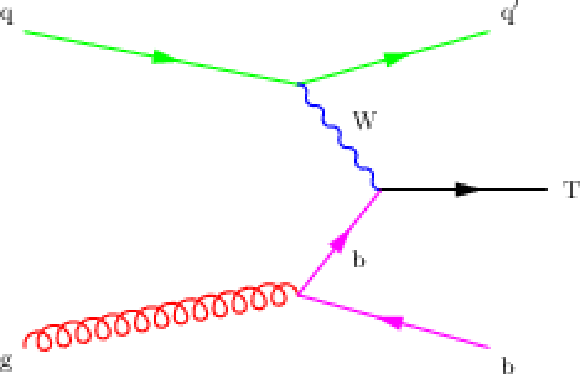
png pdf |
Figure 1-a:
Example production diagram for the process ${\mathrm{ p } \mathrm{ p } \to {\mathrm {T}} \mathrm{ b } \mathrm{ q } }$ via the charged current. |
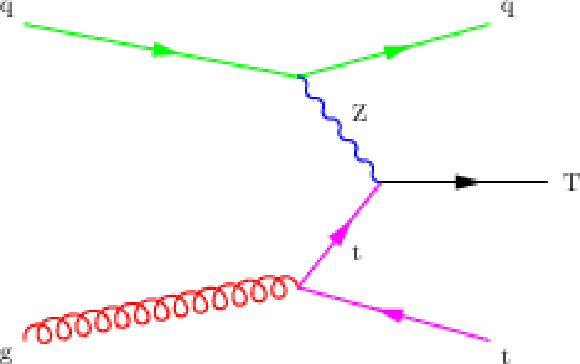
png pdf |
Figure 1-b:
Example production diagram for the process ${\mathrm{ p } \mathrm{ p } \to {\mathrm {T}} \mathrm{ t } \mathrm{ q } }$ via the neutral current. |
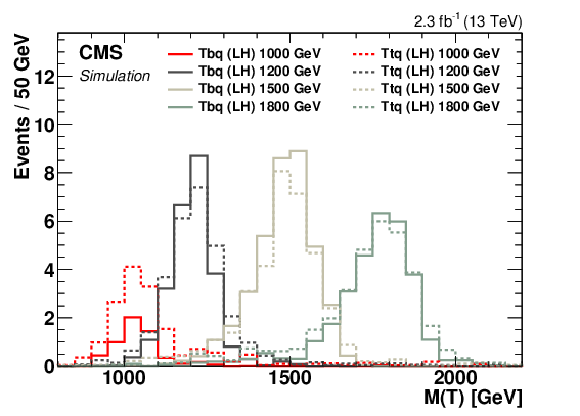
png pdf |
Figure 2:
The simulated ${M(\mathrm {T})}$ distributions for the ${\mathrm{ p } \mathrm{ p } \to {\mathrm {T}} \mathrm{ b } \mathrm{ q } } $ and the ${\mathrm{ p } \mathrm{ p } \to {\mathrm {T}} \mathrm{ t } \mathrm{ q } } $ production modes with left-handed coupling for the T quark masses 1000, 1200, 1500, and 1800 GeV, after all selection criteria have been applied. The values of product of the signal cross sections and the branching fraction $\mathcal {B}( { {\mathrm {T}} \to \mathrm{ t } \mathrm{ H } } )$ are taken to be 1 pb. |

png pdf |
Figure 3:
The ${H_{\mathrm {T}}}$ (left) and ${M(\mathrm {T})}$ (right) distributions after full event selection. The black markers with error bars are the data. The various background components are shown as filled histograms, and are estimated using simulations ($ {{\mathrm{ t } {}\mathrm{ \bar{t} } } \text {+jets}}$ and ${\mathrm{ W } \text {+jets}} $) and the data (non-$ {{\mathrm{ t } {}\mathrm{ \bar{t} } } \text {+jets}}$ and non-$ {\mathrm{ W } \text {+jets}}$ multijets component). The simulated T quark signal distributions for two T quark masses are also shown. The values of product of the signal cross sections and the branching fraction $\mathcal {B}( { {\mathrm {T}} \to \mathrm{ t } \mathrm{ H } } )$ are taken to be 1 pb. |

png pdf |
Figure 3-a:
The ${H_{\mathrm {T}}}$ distribution after full event selection. The black markers with error bars are the data. The various background components are shown as filled histograms, and are estimated using simulations ($ {{\mathrm{ t } {}\mathrm{ \bar{t} } } \text {+jets}}$ and ${\mathrm{ W } \text {+jets}} $) and the data (non-$ {{\mathrm{ t } {}\mathrm{ \bar{t} } } \text {+jets}}$ and non-$ {\mathrm{ W } \text {+jets}}$ multijets component). The simulated T quark signal distributions for two T quark masses are also shown. The values of product of the signal cross sections and the branching fraction $\mathcal {B}( { {\mathrm {T}} \to \mathrm{ t } \mathrm{ H } } )$ are taken to be 1 pb. |

png pdf |
Figure 3-b:
The ${M(\mathrm {T})}$ distribution after full event selection. The black markers with error bars are the data. The various background components are shown as filled histograms, and are estimated using simulations ($ {{\mathrm{ t } {}\mathrm{ \bar{t} } } \text {+jets}}$ and ${\mathrm{ W } \text {+jets}} $) and the data (non-$ {{\mathrm{ t } {}\mathrm{ \bar{t} } } \text {+jets}}$ and non-$ {\mathrm{ W } \text {+jets}}$ multijets component). The simulated T quark signal distributions for two T quark masses are also shown. The values of product of the signal cross sections and the branching fraction $\mathcal {B}( { {\mathrm {T}} \to \mathrm{ t } \mathrm{ H } } )$ are taken to be 1 pb. |

png pdf |
Figure 4:
The expected and observed 95% confidence level upper limits on the product of the signal cross section and the branching fraction $\mathcal {B}( { {\mathrm {T}} \to \mathrm{ t } \mathrm{ H } } )$ for the processes ${\mathrm{ p } \mathrm{ p } \to {\mathrm {T}} \mathrm{ b } \mathrm{ q } }$ (upper figures) and ${\mathrm{ p } \mathrm{ p } \to {\mathrm {T}} \mathrm{ t } \mathrm{ q } }$ (lower figures), for different assumed values of the T quark mass, and with left-handed (left figures) and right-handed (right figures) couplings to the standard model third-generation quarks. The expected 1 and 2 standard deviation (s. d.) uncertainty bands are also shown. The limits are obtained assuming a resonance width of 10 GeV for the T quark. The dot-dashed curves in the upper left and lower right figures correspond to those predicted by the Simplest Simplified Model of Refs. [18,59], which predicts the existence of a left-handed and right-handed coupling for a singlet and doublet T quark, respectively. The benchmark coupling parameter values of $ {c^{{\mathrm{ b } \mathrm{ W } }}} _\mathrm {L} =$ 0.5 and $ {c^{\mathrm{ t } {\mathrm{ Z } } }} _\mathrm {R} = $ 0.5 are chosen for the comparison. |
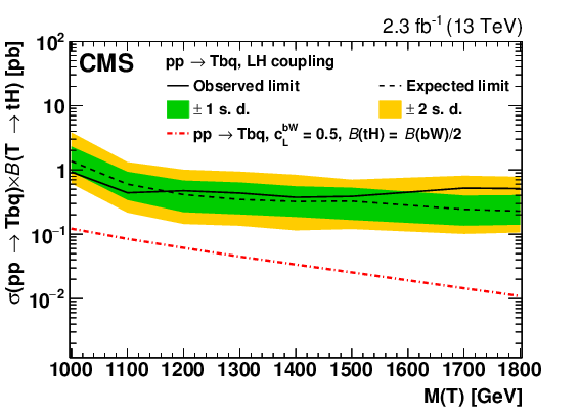
png pdf |
Figure 4-a:
The expected and observed 95% confidence level upper limit on the product of the signal cross section and the branching fraction $\mathcal {B}( { {\mathrm {T}} \to \mathrm{ t } \mathrm{ H } } )$ for the processes ${\mathrm{ p } \mathrm{ p } \to {\mathrm {T}} \mathrm{ b } \mathrm{ q } }$, for different assumed values of the T quark mass, and with left-handed couplings to the standard model third-generation quarks. The expected 1 and 2 standard deviation (s. d.) uncertainty bands are also shown. The limits are obtained assuming a resonance width of 10 GeV for the T quark. The dot-dashed curve corresponds to that predicted by the Simplest Simplified Model of Refs. [18,59], which predicts the existence of a left-handed coupling for a singlet T quark. The benchmark coupling parameter value of $ {c^{{\mathrm{ b } \mathrm{ W } }}} _\mathrm {L} =$ 0.5 is chosen for the comparison. |
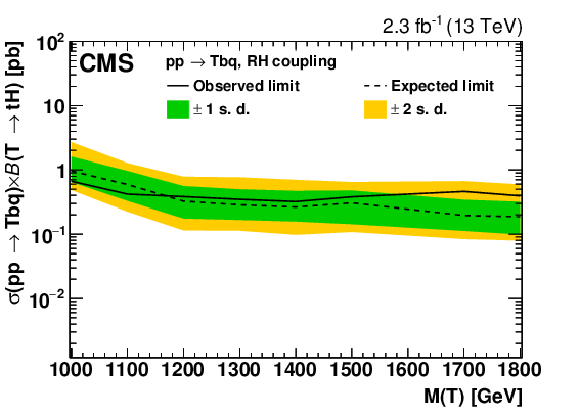
png pdf |
Figure 4-b:
The expected and observed 95% confidence level upper limit on the product of the signal cross section and the branching fraction $\mathcal {B}( { {\mathrm {T}} \to \mathrm{ t } \mathrm{ H } } )$ for the processes ${\mathrm{ p } \mathrm{ p } \to {\mathrm {T}} \mathrm{ b } \mathrm{ q } }$, for different assumed values of the T quark mass, and with right-handed couplings to the standard model third-generation quarks. The expected 1 and 2 standard deviation (s. d.) uncertainty bands are also shown. The limits are obtained assuming a resonance width of 10 GeV for the T quark. |

png pdf |
Figure 4-c:
The expected and observed 95% confidence level upper limit on the product of the signal cross section and the branching fraction $\mathcal {B}( { {\mathrm {T}} \to \mathrm{ t } \mathrm{ H } } )$ for the processes ${\mathrm{ p } \mathrm{ p } \to {\mathrm {T}} \mathrm{ b } \mathrm{ q } }$, for different assumed values of the T quark mass, and with left-handed couplings to the standard model third-generation quarks. The expected 1 and 2 standard deviation (s. d.) uncertainty bands are also shown. The limits are obtained assuming a resonance width of 10 GeV for the T quark. |

png pdf |
Figure 4-d:
The expected and observed 95% confidence level upper limit on the product of the signal cross section and the branching fraction $\mathcal {B}( { {\mathrm {T}} \to \mathrm{ t } \mathrm{ H } } )$ for the processes ${\mathrm{ p } \mathrm{ p } \to {\mathrm {T}} \mathrm{ t } \mathrm{ q } }$, for different assumed values of the T quark mass, and with lright-handed couplings to the standard model third-generation quarks. The expected 1 and 2 standard deviation (s. d.) uncertainty bands are also shown. The limits are obtained assuming a resonance width of 10 GeV for the T quark. The dot-dashed curve corresponds to that predicted by the Simplest Simplified Model of Refs. [18,59], which predicts the existence of a right-handed coupling for a doublet T quark. The benchmark coupling parameter value of $ {c^{\mathrm{ t } {\mathrm{ Z } } }} _\mathrm {R} = $ 0.5 is chosen for the comparison. |
| Tables | |
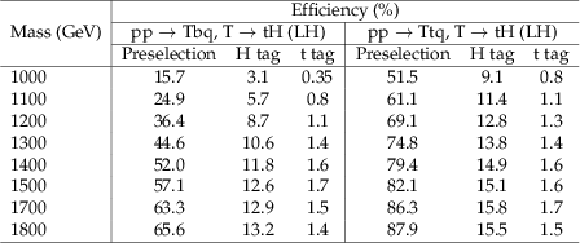
png pdf |
Table 1:
The signal efficiencies for successive event selections for the ${\mathrm{ p } \mathrm{ p } \to {\mathrm {T}} \mathrm{ b } \mathrm{ q } }$ and ${\mathrm{ p } \mathrm{ p } \to {\mathrm {T}} \mathrm{ t } \mathrm{ q } }$ models with left-handed couplings. The preselection criteria are more efficient for the ${\mathrm{ p } \mathrm{ p } \to {\mathrm {T}} \mathrm{ t } \mathrm{ q } }$ process compared to the ${\mathrm{ p } \mathrm{ p } \to {\mathrm {T}} \mathrm{ b } \mathrm{ q } }$ process owing to the larger number of jets, and hence a higher $ {H_{\mathrm {T}}} $ per event, in the former. This is more pronounced for low T quark mass samples, where the ${H_{\mathrm {T}}}$ is close to the trigger threshold of 800 GeV. |

png pdf |
Table 2:
Number of events for the control regions A, B, and C in the data, and in the non-multijet backgrounds. The difference between the data and the ${{\mathrm{ t } {}\mathrm{ \bar{t} } } \text {+jets}} $, ${\mathrm{ W } \text {+jets}} $, and the $\mathrm{ t } \mathrm{ W } $ backgrounds is attributed to the multijets background component. The uncertainties are statistical only. |
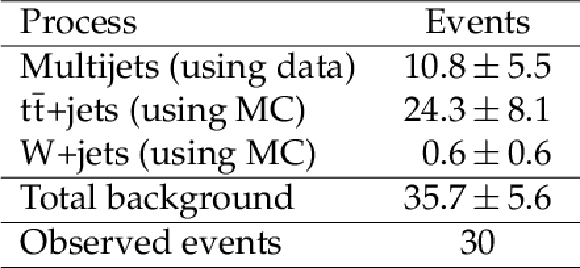
png pdf |
Table 3:
Estimated background and the number of observed events in the signal region after all selection criteria. The combined statistical and systematic uncertainty is shown. |
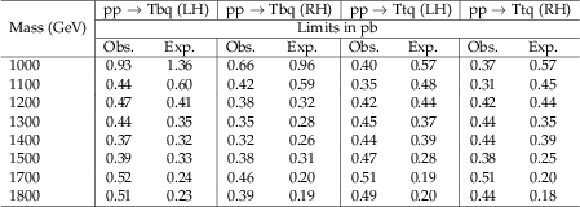
png pdf |
Table 4:
The observed and expected 95% confidence level upper limits on the product of the signal cross sections and the branching fraction $\cal {B}( { {\mathrm {T}} \to \mathrm{ t } \mathrm{ H } } )$, for various masses of the T quark. |
| Summary |
| A search for a vector-like top quark partner T in the single production mode is performed using proton-proton collision events at $ \sqrt{s} = $ 13 TeV collected by the CMS experiment in 2015. The T quarks are assumed to couple only to the standard model third-generation quarks. The decay channel exploited is ${{\mathrm{T}} \to \mathrm{t } \mathrm{ H }} $, with hadronic top quark decay and ${\mathrm{ H }\to\mathrm{ b \bar{b} }} $. Boosted H and t tagging techniques are used to identify the Higgs boson and the top quark decays in the final state, and the invariant mass of the two gives the T quark candidate mass. The background is mostly due to the standard model ${\mathrm{ t \bar{t} }\text{+jets}} $, with some contribution from multijet and W+jets processes. No significant excess of data above the background is observed in the T quark candidate mass distribution. The 95% confidence level upper limits on the product of the signal cross sections and the branching fraction $\mathcal{B}({{\mathrm{T}} \to \mathrm{t } \mathrm{ H }} )$ are set using Bayesian statistics. These vary between 0.31-0.93 pb for a T quark of mass ranging from 1000 to 1800 GeV, in the ${\mathrm{ p }\mathrm{ p }\to{\mathrm{T}} \mathrm{b }\mathrm{ q }} $ and ${\mathrm{ p }\mathrm{ p }\to{\mathrm{T}} \mathrm{t }\mathrm{ q }} $ production channels with left-handed and right-handed couplings to the standard model third-generation quarks. In the mass range considered for this analysis, the search sensitivity is essentially the same as that using leptonic final states [17]. The use of boosted techniques has led to an extension of the search region beyond those of previous analyses. This is the first time fully hadronic final states have been exploited in the search for single electroweak production of vector-like quarks at a hadron collider. |
| References | ||||
| 1 | M. Schmaltz and D. Tucker-Smith | Little Higgs review | Ann. Rev. Nucl. Part. Sci. 55 (2005) 229 | hep-ph/0502182 |
| 2 | M. Perelstein, M. E. Peskin, and A. Pierce | Top quarks and electroweak symmetry breaking in little Higgs models | PRD 69 (2004) 075002 | hep-ph/0310039 |
| 3 | I. Antoniadis, K. Benakli, and M. Quiros | Finite Higgs mass without supersymmetry | New J. Phys. 3 (2001) 20 | hep-th/0108005 |
| 4 | Y. Hosotani, S. Noda, and K. Takenaga | Dynamical gauge-Higgs unification in the electroweak theory | PLB 607 (2005) 276 | hep-ph/0410193 |
| 5 | K. Agashe, R. Contino, and A. Pomarol | The minimal composite Higgs model | Nucl. Phys. B 719 (2005) 165 | hep-ph/0412089 |
| 6 | R. Contino, L. Da Rold, and A. Pomarol | Light custodians in natural composite Higgs models | PRD 75 (2007) 055014 | hep-ph/0612048 |
| 7 | P. H. Frampton, P. Q. Hung, and M. Sher | Quarks and leptons beyond the third generation | PR 330 (2000) 263 | hep-ph/9903387 |
| 8 | A. De Simone, O. Matsedonskyi, R. Rattazzi, and A. Wulzer | A first top partner hunter's guide | JHEP 04 (2013) 004 | 1211.5663 |
| 9 | Y. Okada and L. Panizzi | LHC signatures of vector-like quarks | Adv. High Energy Phys. 2013 (2013) 364936 | 1207.5607 |
| 10 | ATLAS and CMS Collaborations | Measurements of the Higgs boson production and decay rates and constraints on its couplings from a combined ATLAS and CMS analysis of the LHC pp collision data at $ \sqrt{s}= $ 7 and 8 TeV | JHEP 08 (2016) 045 | 1606.02266 |
| 11 | ATLAS Collaboration | Search for production of vector-like quark pairs and of four top quarks in the lepton-plus-jets final state in pp collisions at $ \sqrt{s}=8 $ TeV with the ATLAS detector | JHEP 08 (2015) 105 | 1505.04306 |
| 12 | CMS Collaboration | Search for vector-like charge 2/3 T quarks in proton-proton collisions at $ \sqrt{s} $ = 8 TeV | PRD 93 (2016) 012003 | CMS-B2G-13-005 1509.04177 |
| 13 | ATLAS Collaboration | Search for single production of vector-like quarks decaying into $ Wb $ in pp collisions at $ \sqrt{s} = $ 8 TeV with the ATLAS detector | EPJC 76 (2016) 442 | 1602.05606 |
| 14 | J. A. Aguilar-Saavedra, R. Benbrik, S. Heinemeyer, and M. P\'erez-Victoria | Handbook of vectorlike quarks: Mixing and single production | PRD 88 (2013) 094010 | 1306.0572 |
| 15 | ATLAS and CMS Collaborations | Combined Measurement of the Higgs Boson Mass in $ \mathrm{ p }\mathrm{ p } $ Collisions at $ \sqrt{s}= $ 7 and 8 TeV with the ATLAS and CMS Experiments | PRL 114 (2015) 191803 | 1503.07589 |
| 16 | The LHC Higgs Cross Section Working Group | CERN Report 4: Part I Standard Model Predictions | CERN Report LHCHXSWG-DRAFT-INT-2016-008, CERN | |
| 17 | CMS Collaboration | Search for single production of a heavy vector-like T quark decaying to a Higgs boson and a top quark with a lepton and jets in the final state | Submitted to PLB | CMS-B2G-15-008 1612.00999 |
| 18 | O. Matsedonskyi, G. Panico, and A. Wulzer | On the interpretation of Top Partners searches | JHEP 12 (2014) 097 | 1409.0100 |
| 19 | J. Alwall et al. | The automated computation of tree-level and next-to-leading order differential cross sections, and their matching to parton shower simulations | JHEP 07 (2014) 079 | 1405.0301 |
| 20 | R. D. Ball et al. | Parton distributions for the LHC Run II | JHEP 04 (2015) 40 | 1410.8849 |
| 21 | M. Czakon and A. Mitov | Top++: A Program for the Calculation of the Top-Pair Cross-Section at Hadron Colliders | CPC 185 (2014) 2930 | 1112.5675 |
| 22 | N. Kidonakis | Two-loop soft anomalous dimensions for single top quark associated production with a $ {\rm W}^{-} $ or $ {\rm H}^{-} $ | PRD 82 (2010) 054018 | 1005.4451 |
| 23 | N. Kidonakis | Top Quark Production | in Proceedings, Helmholtz International Summer School on Physics of Heavy Quarks and Hadrons (HQ 2013), DESY | 1311.0283 |
| 24 | Y. Li and F. Petriello | Combining QCD and electroweak corrections to dilepton production in FEWZ | PRD 86 (2012) 094034 | 1208.5967 |
| 25 | P. Nason | A new method for combining NLO QCD with shower Monte Carlo algorithms | JHEP 11 (2004) 040 | hep-ph/0409146 |
| 26 | S. Frixione, P. Nason, and C. Oleari | Matching NLO QCD computations with Parton Shower simulations: the POWHEG method | JHEP 11 (2007) 070 | 0709.2092 |
| 27 | S. Alioli, P. Nason, C. Oleari, and E. Re | A general framework for implementing NLO calculations in shower Monte Carlo programs: the POWHEG BOX | JHEP 06 (2010) 043 | 1002.2581 |
| 28 | S. Frixione, G. Ridolfi, and P. Nason | A positive-weight next-to-leading-order Monte Carlo for heavy flavour hadroproduction | JHEP 09 (2007) 126 | 0707.3088 |
| 29 | T. Sjostrand, S. Mrenna, and P. Z. Skands | A brief introduction to PYTHIA 8.1 | CPC 178 (2008) 852 | 0710.3820 |
| 30 | CMS Collaboration | Event generator tunes obtained from underlying event and multiparton scattering measurements | EPJC 76 (2016) 155 | CMS-GEN-14-001 1512.00815 |
| 31 | M. L. Mangano, M. Moretti, F. Piccinini, and M. Treccani | Matching matrix elements and shower evolution for top-quark production in hadronic collisions | JHEP 01 (2007) 013 | hep-ph/0611129 |
| 32 | ATLAS Collaboration | Measurement of the Inelastic Proton-Proton Cross Section at $ \sqrt{s} = $ 13 TeV with the ATLAS Detector at the LHC | Submitted to PRLett | 1606.02625 |
| 33 | J. Allison et al. | GEANT4 developments and applications | IEEE Trans. Nucl. Sci. 53 (2006) 270 | |
| 34 | J. Allison et al. | Recent developments in Geant4 | NIMA 835 (2016) 186 | |
| 35 | CMS Collaboration | The CMS experiment at the CERN LHC | JINST 3 (2008) S08004 | CMS-00-001 |
| 36 | CMS Collaboration | Particle--Flow Event Reconstruction in CMS and Performance for Jets, Taus, and $ E_{\mathrm{T}}^{\text{miss}} $ | CDS | |
| 37 | CMS Collaboration | Commissioning of the Particle-flow Event Reconstruction with the first LHC collisions recorded in the CMS detector | CDS | |
| 38 | M. Cacciari, G. P. Salam, and G. Soyez | The anti-$ k_t $ jet clustering algorithm | JHEP 04 (2008) 063 | 0802.1189 |
| 39 | M. Cacciari, G. P. Salam, and G. Soyez | FastJet user manual | EPJC 72 (2012) 1896 | 1111.6097 |
| 40 | M. Cacciari and G. P. Salam | Dispelling the $ N^{3} $ myth for the $ k_t $ jet-finder | PLB 641 (2006) 57 | hep-ph/0512210 |
| 41 | M. Cacciari and G. P. Salam | Pileup subtraction using jet areas | PLB 659 (2008) 119 | 0707.1378 |
| 42 | CMS Collaboration | Determination of jet energy calibration and transverse momentum resolution in CMS | JINST 6 (2011) P11002 | CMS-JME-10-011 1107.4277 |
| 43 | CMS Collaboration | Jet energy scale and resolution in the CMS experiment in pp collisions at 8 TeV | Submitted to JINST | CMS-JME-13-004 1607.03663 |
| 44 | CMS Collaboration | Jet Performance in pp Collisions at $ \sqrt{s} = $ 7 TeV | CDS | |
| 45 | G. P. Salam | Towards jetography | EPJC 67 (2010) 637 | 0906.1833 |
| 46 | S. D. Ellis, C. K. Vermilion, and J. R. Walsh | Recombination algorithms and jet substructure: Pruning as a Tool for Heavy Particle searches | PRD 81 (2010) 094023 | 0912.0033 |
| 47 | M. Dasgupta, A. Fregoso, S. Marzani, and G. P. Salam | Towards an understanding of jet substructure | JHEP 09 (2013) 029 | 1307.0007 |
| 48 | A. J. Larkoski, S. Marzani, G. Soyez, and J. Thaler | Soft drop | JHEP 05 (2014) 146 | 1402.2657 |
| 49 | CMS Collaboration | Identification techniques for highly boosted W bosons that decay into hadrons | JHEP 12 (2014) 017 | CMS-JME-13-006 1410.4227 |
| 50 | CMS Collaboration | Boosted Top Jet Tagging at CMS | CMS-PAS-JME-13-007 | CMS-PAS-JME-13-007 |
| 51 | J. Thaler and K. Van Tilburg | Identifying boosted objects with N-subjettiness | JHEP 03 (2011) 015 | 1011.2268 |
| 52 | CMS Collaboration | Identification of b-quark jets with the CMS experiment | JINST 8 (2013) P04013 | CMS-BTV-12-001 1211.4462 |
| 53 | CMS Collaboration | Identification of b quark jets at the CMS Experiment in the LHC Run 2 | CMS-PAS-BTV-15-001 | CMS-PAS-BTV-15-001 |
| 54 | CMS Collaboration | Top Tagging with New Approaches | CDS | |
| 55 | CMS Collaboration | CMS Luminosity Measurement for the 2015 Data Taking Period | CMS-PAS-LUM-15-001 | CMS-PAS-LUM-15-001 |
| 56 | J. Butterworth et al. | PDF4LHC recommendations for LHC Run II | JPG 43 (2016) 023001 | 1510.03865 |
| 57 | D. Lindley | Kendall's Advanced Theory of Statistics, volume 2B, Bayesian Inference, 2nd edn | Journal of the Royal Statistical Society: Series A (Statistics in Society) 168 (2005) 259 | |
| 58 | ATLAS and CMS Collaborations, and the LHC Higgs Combination Group | Procedure for the LHC Higgs boson search combination in Summer 2011 | CMS-NOTE-2011-005 | |
| 59 | J. M. Campbell, R. K. Ellis, and F. Tramontano | Single top production and decay at next-to-leading order | PRD 70 (2004) 094012 | hep-ph/0408158 |

|
Compact Muon Solenoid LHC, CERN |

|

|

|

|

|

|